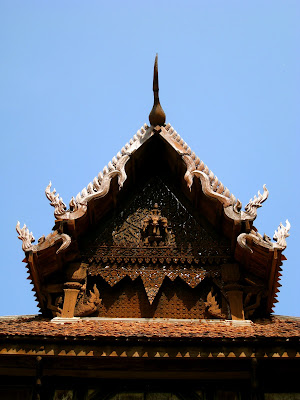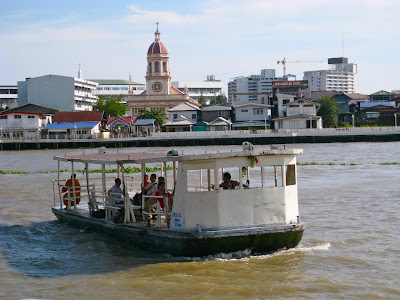The city was founded by King Ramathibodi I (U-Thong) in 1350 on a island within a bend of the Chao Phraya river, which had been the former seaport city of Ayothaya. By the beginning of the 15th century, Ayutthaya was regarded as the strongest power in the 'Indochina' region. In the sixteenth century, the city was described by foreign traders as being one of the biggest and wealthiest in the East.
1686 French drawn map of Siam
Constantly at war with her neighbours, fighting off rebellions within her provinces, Ayutthaya was finally conquered and sacked by the Burmese in 1767. Siam's capital moving south, first to Thon-Buri, then across the Chao Phraya River to present-day Bangkok.
Today only the ruins testify to the former splendours of the old capital. The modern day city being founded a few kilometres further east. What remains of ancient city, form the 'Ayutthaya Historical Park' being declared an UNESCO World Heritage Site since December 1991. And it is to here that I have come to visit.........
Having arrived by train, my first stop is to catch a ferry across the river -
Armed with a map, I had alredy decided which places I wished to visit.....
The Chantharakasem Museum
This is a National museum and was originally known as the Chan Kasem Palace, being the principle residence of King Naresaun established in 1577 when he was Crown Prince. The palace was destroyed by the Burmese in 1767 and remained in ruins until the reign of King Rama IV who, in 1936, rebuilt it as the museum we see today.
The remains of the Royal Palace
When King Ramathibodi founded the city in 1350, he ordered the building of a royal palace at the same time. Today, the only reminder that a building existed are a few remains of the brick foundations.
Wat Phra Si Sanphet
The three bell-shaped chedis of Wat Phra Si Sanphet have practically become synonymous with Ayutthaya.
Wat Phra Si Sanphet was built by King Bromatrailokanat in 1448 and was reportedly one of the grandest temples in the ancient capital and is still on of the best preserved. The temple took its name from the large standing Buddha image erected on the site in 1503. Later when the image was smashed by the Burmese in 1767, King Rama I had the remaining pieces collected and placed in a chedi at Wat Pho in Bangkok.
The three chedis were built to contain the ashes of King Boromatrailokanat and his two sons, King Ramathibodhi and King Boromatrailokanat II. Surrounding these chedis was a large cloister with further smaller chedis placed near the outer wall.
The Temple was originally connected directly with the royal palace.
Wat Phra Si Sanphet was built by King Bromatrailokanat in 1448 and was reportedly one of the grandest temples in the ancient capital and is still on of the best preserved. The temple took its name from the large standing Buddha image erected on the site in 1503. Later when the image was smashed by the Burmese in 1767, King Rama I had the remaining pieces collected and placed in a chedi at Wat Pho in Bangkok.
The three chedis were built to contain the ashes of King Boromatrailokanat and his two sons, King Ramathibodhi and King Boromatrailokanat II. Surrounding these chedis was a large cloister with further smaller chedis placed near the outer wall.
The Temple was originally connected directly with the royal palace.
On the east side of the Royal palace lies the remains of Wat Phra Ram. The Temple was built in 1369 by King Ramesavara on the cremation site of his father, King U-Thong. Wat Phra ram is dominated by the central towering Prang, which, although badly damaged, still shows enough to gain an idea how rich in detail it must have been.
My final destination was to Wat Ratchburana.
The Temple was built by King Borom Ratchathirat II in 1424 at the place where both his brothers died having killed each other during a fight for the vacant throne of Ayutthaya, following the death of their father........













































































